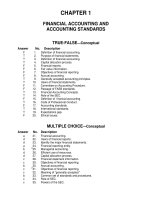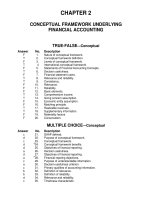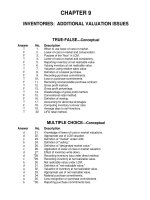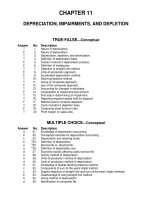Intermediate accounting 16e by kieso slide ch03
Bạn đang xem bản rút gọn của tài liệu. Xem và tải ngay bản đầy đủ của tài liệu tại đây (3.29 MB, 119 trang )
3-1
PREVIEW OF CHAPTER 3
Intermediate Accounting
16th Edition
Kieso ● Weygandt ● Warfield
3-2
3
The Accounting Information System
LEARNING OBJECTIVES
After studying this chapter, you should be able to:
1
Understand the basic accounting information
4
system.
Prepare financial statements from the adjusted trial
balance.
2
Record and summarize basic transactions.
5
Prepare closing entries.
3
Identify and prepare adjusting entries.
6
Prepare financial statements for a merchandising
company.
3-3
LO 1
ACCOUNTING INFORMATION SYSTEM
Accounting information system
3-4
Collects and processes transaction data.
Disseminates the financial information to interested parties.
LO 1
ACCOUNTING INFORMATION SYSTEM
Helps management answer such questions as:
3-5
How much and what kind of debt is outstanding?
Were sales higher this period than last?
What assets do we have?
What were our cash inflows and outflows?
Did we make a profit last period?
Are any of our product lines or divisions operating at a loss?
Can we safely increase our dividends to stockholders?
Is our rate of return on net assets increasing?
LO 1
ACCOUNTING INFORMATION SYSTEM
Basic Terminology
3-6
Event
Journal
Transaction
Posting
Account
Trial Balance
Real Account
Adjusting Entries
Nominal Account
Financial Statements
Ledger
Closing Entries
LO 1
ACCOUNTING INFORMATION SYSTEM
Debits and Credits
An account shows the effect of transactions on a given asset, liability, equity, revenue, or expense
account.
3-7
Double-entry accounting system (two-sided effect).
Recording done by debiting at least one account and crediting another.
DEBITS must equal CREDITS.
LO 1
Debits and Credits
Account
An arrangement that shows the effect of transactions on
an account.
Debit = “Left”
Credit = “Right”
An Account can be illustrated in
a T-Account form.
3-8
LO 1
Debits and Credits
If the sum of Debit entries are greater than the sum of Credit entries, the account will have a
debit balance.
Transaction #1
$10,000
Transaction #3
8,000
Balance
3-9
$3,000
Transaction #2
$15,000
LO 1
Debits and Credits
If the sum of Credit entries are greater than the sum of Debit entries, the account will have a
credit balance.
Transaction #1
Balance
3-10
$10,000
$3,000
Transaction #2
8,000
Transaction #3
$1,000
LO 1
Debits and Credits Summary
3-11
Normal
NormalBalance
Balance
Normal
NormalBalance
Balance
Debit
Debit
Credit
Credit
LO 1
Debits and Credits Summary
Balance Sheet
Asset
=
Liability
Income Statement
+ Equity
Revenue
- Expense
Debit
Credit
3-12
LO 1
The Accounting Equation
Relationship among the assets, liabilities and stockholders’ equity accounts of a business:
ILLUSTRATION 3-3
Expanded Equation and Debit/Credit Rules and Effects
The equation must be in balance after every transaction. For every Debit there must be a Credit.
3-13
LO 1
Double-Entry System Illustration
1.
Owners invest $40,000 in exchange for common stock.
Assets
Assets
+ 40,000
3-14
=
Liabilities
Liabilities
+
Stockholders’
Stockholders’ Equity
Equity
+ 40,000
LO 1
Double-Entry System Illustration
2.
Disburse $600 cash for secretarial wages.
Assets
Assets
- 600
3-15
=
Liabilities
Liabilities
+
Stockholders’
Stockholders’ Equity
Equity
- 600 (expense)
LO 1
Double-Entry System Illustration
3.
Purchase office equipment priced at $5,200, giving a 10 percent promissory note in
exchange.
Assets
Assets
+ 5,200
3-16
=
Liabilities
Liabilities
+
Stockholders’
Stockholders’ Equity
Equity
+ 5,200
LO 1
Double-Entry System Illustration
4.
Received $4,000 cash for services performed.
Assets
Assets
+ 4,000
3-17
=
Liabilities
Liabilities
+
Stockholders’
Stockholders’ Equity
Equity
+ 4,000 (revenue)
LO 1
Double-Entry System Illustration
5.
Pay off a short-term liability of $7,000.
Assets
Assets
- 7,000
3-18
=
Liabilities
Liabilities
+
Stockholders’
Stockholders’ Equity
Equity
- 7,000
LO 1
Double-Entry System Illustration
6.
Declared a cash dividend of $5,000.
Assets
Assets
=
Liabilities
Liabilities
+ 5,000
3-19
+
Stockholders’
Stockholders’ Equity
Equity
- 5,000
LO 1
Double-Entry System Illustration
7.
Convert a long-term liability of $80,000 into common stock.
Assets
Assets
=
Liabilities
Liabilities
- 80,000
3-20
+
Stockholders’
Stockholders’ Equity
Equity
+ 80,000
LO 1
Double-Entry System Illustration
8.
Pay cash of $16,000 for a delivery van.
=
Assets
Assets
Liabilities
Liabilities
+
Stockholders’
Stockholders’ Equity
Equity
- 16,000
+ 16,000
Note that the accounting equation equality is maintained after recording each transaction.
Note that the accounting equation equality is maintained after recording each transaction.
3-21
LO 1
Ownership Structure
Ownership structure dictates the types of accounts that are part of or affect the equity section.
Proprietorship
Proprietorship or
or
Partnership
Partnership
Corporation
Corporation
Owner’s Capital
Common Stock
Owner’s Drawing
Paid-in Capital in Excess of Par
Dividends
Retained Earnings
3-22
LO 1
Financial Statements
Balance Sheet
Stockholders’
Stockholders’ Equity
Equity
Common
Common Stock
Stock
Retained
Retained Earnings
Earnings
(investments
(investments by
by stockholders)
stockholders)
(net
(net income
income retained
retained in
in business)
business)
Net
Net income
income or
or Net
Net loss
loss (revenues
(revenues less
less expenses)
expenses)
Dividends
Dividends
Income
Income Statement
Statement
Statement of Retained Earnings
ILLUSTRATION 3-4
3-23
Financial Statements and Ownership Structure
LO 1
The Accounting Cycle
ILLUSTRATION 3-6
The Accounting Cycle
Transactions
Transactions
Reversing
Reversing entries
entries
Journalization
Journalization
Post-closing
Post-closing trail
trail balance
balance
Posting
Posting
Closing
Closing
Trial
Trial balance
balance
Statement
Statement preparation
preparation
Work
WorkSheet
Sheet
Adjustments
Adjustments
Adjusted
Adjusted trial
trial balance
balance
3-24
LO 1
Identify and Recording Transactions
What to Record?
The FASB uses the phrase “transactions and other events and circumstances that affect a business
enterprise.”
Types of Events:
3-25
External – between an entity and its environment.
Internal – event occurring entirely within an entity.
LO 1









